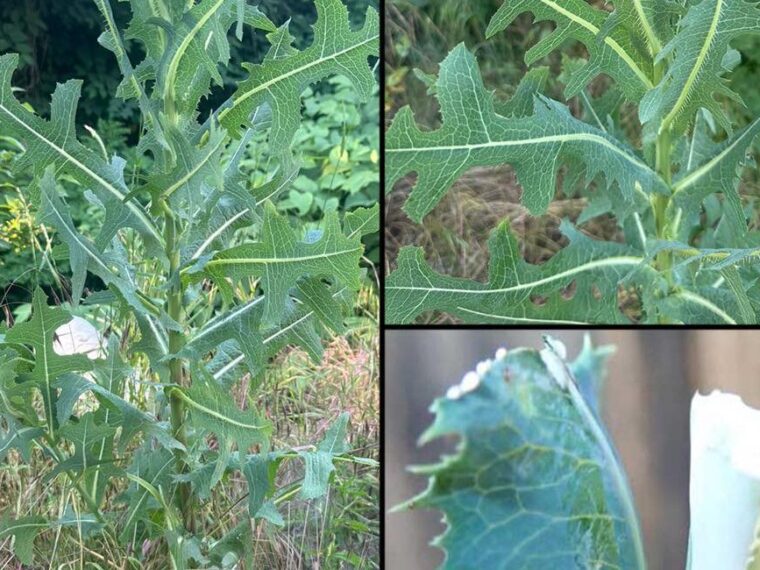Wild lettuce (Lactuca virosa), often overlooked as a common weed, harbors a secret more precious than many realize. The plant, found abundantly along roadsides, fields, and disturbed soils, produces a milky white sap called lactucarium — a substance historically valued as a natural analgesic and mild sedative. Though lacking the addictive opiates found in poppy plants, wild lettuce sap has been used for centuries to alleviate pain, promote relaxation, and support restful sleep.
In this comprehensive guide, you will discover the fascinating history, step-by-step techniques for harvesting wild lettuce sap, its powerful therapeutic properties, practical methods of use, and important safety considerations. Whether you are a herbal enthusiast, a natural health seeker, or simply curious about this extraordinary plant, this article will serve as your ultimate resource.
What is Wild Lettuce (Lactuca virosa)?
Before delving into the sap itself, it’s important to understand the plant that produces it. Wild lettuce, scientifically known as Lactuca virosa, is a biennial herb native to Europe but naturalized in many regions worldwide. It belongs to the Asteraceae family and is a close relative of cultivated lettuce, but it is much taller and has distinctly spiny leaves.
Identification Features:
- Height: Can grow up to 6 feet (about 2 meters) tall.
- Leaves: Lance-shaped, spiny edges, blue-green coloration, and often prickly to the touch.
- Stem: Hollow, thick, and exudes a milky white sap when broken.
- Flowers: Small yellow florets clustered at the top during the blooming season.
- Habitat: Prefers sunny, disturbed soils such as roadsides, fields, and riverbanks.
The Magical Milky Sap: Lactucarium
The milky white latex inside wild lettuce is known as lactucarium. This resinous substance oozes from cuts in the stem or leaves and gradually hardens into a brownish gum-like resin when exposed to air.
Historically, lactucarium was prized as a natural alternative to opium and has earned the nickname “opium lettuce” due to its sedative and analgesic effects. Despite its name, wild lettuce contains no morphine or codeine but contains compounds that act on the nervous system in ways that provide pain relief and relaxation.
How to Identify and Harvest Wild Lettuce Sap
Harvesting wild lettuce sap is a delicate process requiring careful plant identification and patient extraction to maximize yield and potency.
Step 1: Identifying the Right Plant
Accurate identification is critical to avoid toxic lookalikes or immature plants with less potent sap.
- Search for tall plants (4-6 feet) with bluish-green leaves and spiny margins.
- Break a stem gently to confirm the presence of milky white sap.
- Avoid plants with no sap or a different coloration.
Step 2: Harvesting the Sap
- Choose mature plants: Older, more developed plants yield more sap.
- Cut near the base: Using a clean, sharp knife, slice the main stem close to the root to induce maximum sap flow.
- Collect the sap: As the white latex oozes out, gather it immediately with a spoon or carefully scrape it onto a clean glass surface.
- Repeat cuts: Make successive incisions higher on the stem and branches to collect additional sap.
- Drying: Allow the collected sap to dry in a clean, dust-free environment to form a sticky, brownish resin.
- Storage: Place the dried resin in airtight containers away from moisture, light, and heat for preservation.
The Science Behind Wild Lettuce Sap: Key Compounds and Effects
Modern phytochemical analysis reveals that wild lettuce contains several bioactive compounds contributing to its therapeutic potential.
Major Active Constituents
- Lactucin and Lactucopicrin: These sesquiterpene lactones are responsible for the sedative and analgesic effects by modulating neurotransmitter activity.
- Flavonoids and Phenolics: Antioxidants that support cellular health and reduce inflammation.
- Other Alkaloids: Mild relaxants impacting central nervous system function.
Effects on the Body
- Pain Relief: By interacting with pain pathways, lactucarium can alleviate headaches, muscle aches, and minor pains.
- Mild Sedation: Acts as a natural relaxant, calming nerves without heavy intoxication.
- Cough Suppression: Traditionally used to reduce persistent cough and irritation in the respiratory tract.
- Anxiety Reduction: Its calming properties help reduce stress and nervousness.
- Sleep Aid: Can promote restful sleep through mild sedative action.
Traditional and Modern Uses of Wild Lettuce Sap
Pain Management
People have long sought natural analgesics to avoid the side effects and dependency risks of pharmaceutical opioids. Wild lettuce sap offers a natural alternative for:
- Headaches and Migraines: Reducing the intensity of pain.
- Muscle and Joint Pain: Useful for mild arthritis or muscle soreness.
- Menstrual Cramps: Relieving discomfort related to menstruation.
Relaxation and Sleep
Lactucarium’s sedative qualities make it popular as a:
- Sleep aid for those suffering from insomnia or restless nights.
- Stress reliever to ease anxiety and tension accumulated during the day.
Respiratory Benefits
Historically, wild lettuce sap was used to soothe:
- Dry coughs and bronchitis symptoms.
- Sinus congestion through its mild anti-inflammatory effects.
Mild Euphoria and Mood Enhancement
While not intoxicating or habit-forming, some users report a sense of well-being and calm after consuming wild lettuce sap, contributing to improved mood.
How to Use Wild Lettuce Sap Safely
Wild lettuce sap can be consumed or applied in several ways depending on the desired effect and convenience.
Common Methods of Use
- Direct Ingestion: Small amounts of the dried resin can be swallowed or dissolved in warm water as a tincture.
- Tea or Infusion: The dried sap or leaves can be steeped in hot water to extract active compounds.
- Capsules or Extracts: Commercial supplements offer standardized doses of lactucarium.
- Topical Application: For localized pain relief, diluted sap or tincture may be applied externally.
Dosage Guidelines
- Start with small doses to assess individual tolerance, as the potency varies by plant and preparation method.
- Typical ingestion ranges from 10 to 50 mg of dried resin per dose.
- Avoid excessive consumption to prevent unwanted side effects such as dizziness or excessive sedation.
Safety Considerations and Potential Side Effects
While wild lettuce is natural, safety precautions are paramount to avoid adverse reactions.
Important Warnings
- Avoid during pregnancy and breastfeeding: Safety is not established.
- Not recommended for children due to potent effects.
- Potential for allergic reactions: Skin irritation or digestive upset may occur.
- Interactions with medications: Especially sedatives, antidepressants, or painkillers.
- Avoid combining with alcohol or narcotics to prevent excessive sedation.
Possible Side Effects
- Mild dizziness or lightheadedness.
- Nausea or upset stomach.
- Excessive drowsiness.
- Allergic skin reactions on contact.
How to Grow Wild Lettuce for Sustainable Sap Harvesting
For those interested in cultivating their own supply, wild lettuce is relatively easy to grow.
Cultivation Tips
- Plant seeds in well-drained, sunny areas during spring.
- Prefers fertile soil with moderate watering.
- Thin seedlings to allow room for growth.
- Harvest sap from mature plants in late summer for best quality.
Wild Lettuce vs. Other Natural Analgesics
Wild lettuce holds a unique position among herbal pain relievers:
- Unlike opium poppy, it lacks addictive alkaloids but still offers meaningful relief.
- Compared to willow bark (natural aspirin source), it also provides mild sedative benefits.
- When contrasted with valerian root or kava kava, wild lettuce has a more balanced combination of analgesic and relaxant effects.
Frequently Asked Questions (FAQs)
Can wild lettuce sap get you “high”?
No, it does not contain narcotic substances. Its effects are mild sedation and relaxation without intoxication.
How long does the effect last?
Typically, effects last 2-4 hours depending on dose and individual sensitivity.
Is it legal to harvest and use wild lettuce?
Yes, wild lettuce is legal in most regions but always check local regulations, especially for commercial use.
Can I overdose on wild lettuce sap?
High doses may cause excessive sedation or nausea but are unlikely to be fatal. Always start small and consult a healthcare provider if unsure.
Conclusion: The Untapped Potential of Wild Lettuce Sap
Wild lettuce sap is a fascinating natural remedy with a long history and a growing reputation in herbal medicine. Its unique combination of mild analgesic and sedative properties offers an appealing alternative for those seeking natural pain relief, relaxation, and respiratory support without the risks associated with opiates or synthetic drugs.
By learning to identify, harvest, and use wild lettuce sap safely and effectively, you can tap into a centuries-old tradition of botanical healing. Whether you choose to experiment with teas, tinctures, or dried resin, this remarkable plant holds the promise of natural wellness right at your fingertips — growing wild and free all around you.




